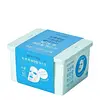What's inside
What's inside
 Key Ingredients
Key Ingredients

 Benefits
Benefits

 Concerns
Concerns

 Ingredients Side-by-side
Ingredients Side-by-side

Water
Skin ConditioningGlycerin
HumectantMethylpropanediol
SolventButylene Glycol
Humectant1,2-Hexanediol
Skin ConditioningSodium Hyaluronate
HumectantSodium Acetylated Hyaluronate
HumectantHydrolyzed Hyaluronic Acid
HumectantLactobacillus/Soybean Ferment Extract
Skin ConditioningLactobacillus/Rice Ferment Filtrate
Skin ConditioningLactobacillus
Skin ConditioningSaccharomyces/Coix Lacryma-Jobi Ma-Yuen Seed Ferment Filtrate
Skin ConditioningSaccharomyces/Potato Extract Ferment Filtrate
HumectantGlycine
BufferingSerine
MaskingGlutamic Acid
HumectantAspartic Acid
MaskingLeucine
Skin ConditioningAlanine
MaskingLysine
Skin ConditioningTyrosine
MaskingPhenylalanine
MaskingThreonine
Proline
Skin ConditioningValine
MaskingIsoleucine
Skin ConditioningHistidine
HumectantMethionine
Skin ConditioningCysteine
AntioxidantTremella Fuciformis Polysaccharide
Emulsion StabilisingPyrus Communis Fruit Extract
Skin ConditioningRosa Damascena Flower Water
MaskingCucumis Melo Fruit Extract
Skin ConditioningVetiveria Zizanoides Root Oil
MaskingHedera Helix Leaf/Stem Extract
AntimicrobialOlea Europaea Fruit Oil
MaskingButyrospermum Parkii Butter
Skin ConditioningHydrogenated Lecithin
EmulsifyingSqualane
EmollientCholesterol
EmollientCeramide NP
Skin ConditioningPhytosphingosine
Skin ConditioningAcetyl Glucosamine
Skin ConditioningSodium Polygamma-Glutamate
Emulsion StabilisingMusa Sapientum Fruit Extract
Skin ConditioningCaprylic/Capric Triglyceride
MaskingPropanediol
SolventFructan
Skin ConditioningAllantoin
Skin ConditioningTrehalose
HumectantArginine
MaskingDextrin
AbsorbentHydroxypropyl Methylcellulose
Emulsion StabilisingCI 77220
Cosmetic ColorantGlycolic Acid
BufferingHydroxyacetophenone
AntioxidantTocopheryl Acetate
AntioxidantCarbomer
Emulsion StabilisingXanthan Gum
EmulsifyingPolyglyceryl-10 Laurate
Skin ConditioningCitric Acid
BufferingSodium Citrate
BufferingDisodium EDTA
Water, Glycerin, Methylpropanediol, Butylene Glycol, 1,2-Hexanediol, Sodium Hyaluronate, Sodium Acetylated Hyaluronate, Hydrolyzed Hyaluronic Acid, Lactobacillus/Soybean Ferment Extract, Lactobacillus/Rice Ferment Filtrate, Lactobacillus, Saccharomyces/Coix Lacryma-Jobi Ma-Yuen Seed Ferment Filtrate, Saccharomyces/Potato Extract Ferment Filtrate, Glycine, Serine, Glutamic Acid, Aspartic Acid, Leucine, Alanine, Lysine, Tyrosine, Phenylalanine, Threonine, Proline, Valine, Isoleucine, Histidine, Methionine, Cysteine, Tremella Fuciformis Polysaccharide, Pyrus Communis Fruit Extract, Rosa Damascena Flower Water, Cucumis Melo Fruit Extract, Vetiveria Zizanoides Root Oil, Hedera Helix Leaf/Stem Extract, Olea Europaea Fruit Oil, Butyrospermum Parkii Butter, Hydrogenated Lecithin, Squalane, Cholesterol, Ceramide NP, Phytosphingosine, Acetyl Glucosamine, Sodium Polygamma-Glutamate, Musa Sapientum Fruit Extract, Caprylic/Capric Triglyceride, Propanediol, Fructan, Allantoin, Trehalose, Arginine, Dextrin, Hydroxypropyl Methylcellulose, CI 77220, Glycolic Acid, Hydroxyacetophenone, Tocopheryl Acetate, Carbomer, Xanthan Gum, Polyglyceryl-10 Laurate, Citric Acid, Sodium Citrate, Disodium EDTA
 Reviews
Reviews

Ingredients Explained
These ingredients are found in both products.
Ingredients higher up in an ingredient list are typically present in a larger amount.
Butylene Glycol (or BG) is used within cosmetic products for a few different reasons:
Overall, Butylene Glycol is a safe and well-rounded ingredient that works well with other ingredients.
Though this ingredient works well with most skin types, some people with sensitive skin may experience a reaction such as allergic rashes, closed comedones, or itchiness.
Learn more about Butylene GlycolDisodium EDTA plays a role in making products more stable by aiding other preservatives.
It is a chelating agent, meaning it neutralizes metal ions that may be found in a product.
Disodium EDTA is a salt of edetic acid and is found to be safe in cosmetic ingredients.
Learn more about Disodium EDTAGlycerin is already naturally found in your skin. It helps moisturize and protect your skin.
A study from 2016 found glycerin to be more effective as a humectant than AHAs and hyaluronic acid.
As a humectant, it helps the skin stay hydrated by pulling moisture to your skin. The low molecular weight of glycerin allows it to pull moisture into the deeper layers of your skin.
Hydrated skin improves your skin barrier; Your skin barrier helps protect against irritants and bacteria.
Glycerin has also been found to have antimicrobial and antiviral properties. Due to these properties, glycerin is often used in wound and burn treatments.
In cosmetics, glycerin is usually derived from plants such as soybean or palm. However, it can also be sourced from animals, such as tallow or animal fat.
This ingredient is organic, colorless, odorless, and non-toxic.
Glycerin is the name for this ingredient in American English. British English uses Glycerol/Glycerine.
Learn more about GlycerinTocopheryl Acetate is AKA Vitamin E. It is an antioxidant and protects your skin from free radicals. Free radicals damage the skin by breaking down collagen.
One study found using Tocopheryl Acetate with Vitamin C decreased the number of sunburned cells.
Tocopheryl Acetate is commonly found in both skincare and dietary supplements.
Learn more about Tocopheryl AcetateWater. It's the most common cosmetic ingredient of all. You'll usually see it at the top of ingredient lists, meaning that it makes up the largest part of the product.
So why is it so popular? Water most often acts as a solvent - this means that it helps dissolve other ingredients into the formulation.
You'll also recognize water as that liquid we all need to stay alive. If you see this, drink a glass of water. Stay hydrated!
Learn more about WaterXanthan gum is used as a stabilizer and thickener within cosmetic products. It helps give products a sticky, thick feeling - preventing them from being too runny.
On the technical side of things, xanthan gum is a polysaccharide - a combination consisting of multiple sugar molecules bonded together.
Xanthan gum is a pretty common and great ingredient. It is a natural, non-toxic, non-irritating ingredient that is also commonly used in food products.
Learn more about Xanthan Gum